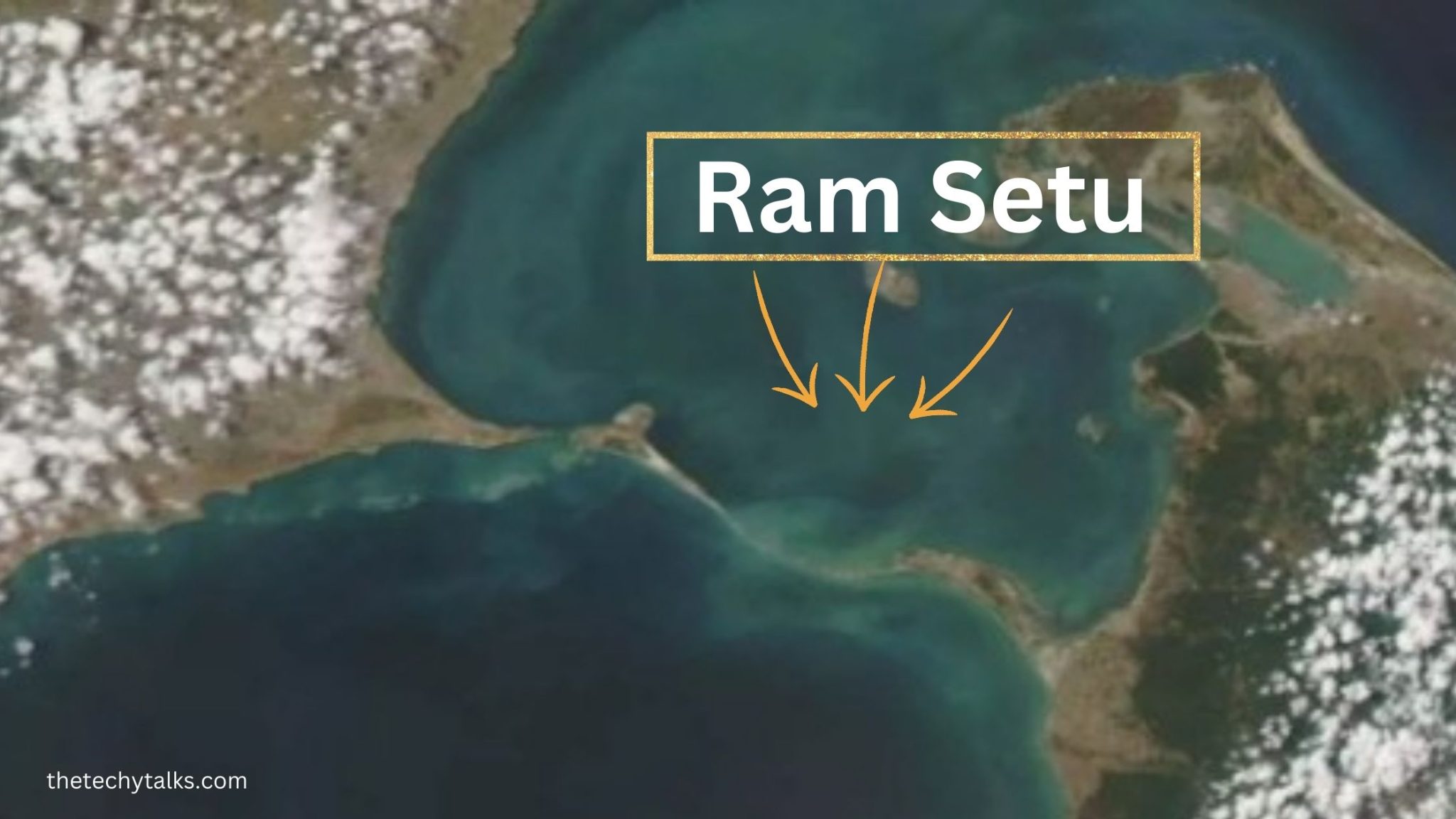
Ram Setu Floating Stone Name | Original Images | Adam's Bridge

The Rameshwaram Ram Setu, also popularly known as Adam's Bridge, is a limestone shoal connecting the southern tip of India with the northeastern coast of Sri Lanka. It is approximately 30 miles (50 km) long and separates the Gulf of Mannar from the Palk Strait. So what is Ram Setu? Ram Setu Underwater is an underwater bridge believed to have been built by the ancient Hindu deity Lord Rama. The bridge is said to have been used by Lord Rama and his army to reach the island of Lanka, where they fought the demon king Ravana.
Today, the bridge is a popular tourist destination, and many people visit it yearly because of the floating stone of Ram Setu.
Ram Setu Bridge History:
The Ram Setu is believed to have been built by the Vanara army of Lord Rama, led by Hanuman, during the Ramayana period. The bridge was used to transport Rama, Sita, and Lakshmana from India to Sri Lanka to rescue Sita from the demon king Ravana.
The floating stone of Ram Setu is connected to the story of Ramayana where the construction of a bridge across the ocean was started to reach Lanka where Goddess Sita was held captive by Ravana. As per the legends the vanara king Hanuman along with his team of monkeys started the task of building the bridge by using a massive boulder that was used in helping the construction. When lord Rama cross is the ocean to Lanka the monkey soldiers Nal and Neer starts building the bridge with the help of Ram and vanar Sena. This bridge is believe to be built 1.7 millions years ago and now the Ram Setu stone sunk into ground leaving a different glow.
Where is Ram Setu Bridge?
The Ram Setu Pul is currently in disrepair, with only a few rocks remaining above the water. However, it still holds great religious and historical significance for Hindus, who believe that a pilgrimage to Rameshwaram, the southernmost tip of India, precisely in Tamil Nadu, is incomplete without taking a dip in the waters of the Palk Strait. See the Ram Setu original image here:
Read Also: Shaligram Stone For Ram Mandir
The Mystery of Ram Setu Stone
The mystery of why Ram Setu stone floats has always been a topic of debate among scientists and devotees. It has been claimed in spiritual textbooks and mythology that the bridge was constructed by Lord Rama. To rescue Sita, who was confined by Ravana in Lanka. However, as per researchers, these are a chain of limestone shoals that float due to the trapped air inside, which results in the floating of rocks.
Read Also: shaligram stone benefits
Why is Ram Setu called Adam's Bridge?
As per popular belief, it is said that Adam, the first human in the world, crossed the bridge from Sri Lanka to India after being expelled from the garden of God, The Eden Garden. That is why this bridge got the name Adam's Bridge.
Sri Panchmukhi Hanuman Mandir & Floating Stones:
The legend goes that Lord Ram and his army of monkeys built this bridge to rescue his wife, Sita, from the clutches of the demon king Ravana.
Interestingly, a floating stone of Ram Setu at Rameshwaram is said to be a part of the Ram Setu. Legend has it that when Lord Ram was building the bridge, one of the stones became loose and started floating. When Ram tried to catch hold of it, the stone slipped from his hands and floated away.
The floating stone is now on display at the Ramanathaswamy Temple in Rameshwaram. It is considered a sacred relic by devotees of Lord Ram and is worshipped as a part of the temple's daily rituals.
Floating Ram Setu Stone Name: Scientific Approach
The scientific explanation for the floating stones of the Ram Setu is that they are floating sandbanks. The sandbanks are formed by sedimentation, where the wind and water deposit sand and other materials. Over time, the sandbanks become compacted and hardened, creating a natural bridge.
The Ram Setu Stone's name in Hindi is "Ram Setu Pul", which is not the only floating stone bridge in the world. There are other examples in India, Pakistan, and even the United States. However, the Sri Lanka Ram Setu is the most famous and revered of all the floating stone bridges.
There is a controversy over whether Ram Setu is a natural formation or man-made. Some believe it is a natural formation, while others believe it is man-made.
Why stones float in Ram Setu scientific reason
It is believed that the Adam's Bridge or Dharam se to have been floating. It is a natural limestone formation that is connected from the Indian subcontinent to Sri Lanka. In the year 2007 NASA Satellite images show that the rocks of the bridge appear to be floating in the water? Is the Ram Setu stone floating for real? This has been a debate for years. If we talk about Ram Setu floating stone scientific validation then as per the reports these are likely to be related to the Puma stones that are known to be floating in the waters around the world. Give me stones are a type of volcanic rocks that are formed after the Lava cools down trapping the gas bubbles or silica inside it. This makes the Rock forest and lightweight which results it into floating into the water.
Ram Setu Scientific Facts:
- Pumice Stone is the Ram Setu stone name.
- There is no scientific proof regarding it being a man made bridge.
- As were the scientific studies it is believe that volcanic stones are used to make the bridge which has silica trapped in it making the stones float on the surface of the water.
Ram Setu Release Date:
The Akshay Kumar-starrer Ram Setu has finally been released. Ram Setu's movie release date is 25th October 2022. The much-anticipated film has been receiving rave reviews from audiences and critics alike. If you want to watch a movie about a massive, ancient bridge, this is the one for you. Ram Setu is a fascinating story, and this movie does a great job of depicting it.
Conclusion:
Overall, Rameshwaram Ram Setu is a popular tourist spot because of its religious significance, natural beauty and the mystery of Ram Setu Stone Floating. The bridge is about 30 miles long and is a beautiful sight to behold. Visitors can take a boat ride to the middle of the bridge to get a closer look at the shoals. There are also several temples and shrines on the bridge, which add to its religious appeal.
Ram Setu is a must-visit for anyone who is interested in Indian mythology or who wants to see one of the most beautiful natural sights in the world.
FAQs:
Ram Setu is a limestone shoals chain between Pamban Island, also known as Rameswaram Island, off the south-eastern coast of Tamil Nadu, India. It is believed to have been formed during the Ice Age when the sea level was lower, and the land between India and Sri Lanka was a land bridge.
There are many theories about who made Ram Setu, also known as Adam's Bridge. Some say it was built by Hanuman, while others believe it was created by a race of superhumans known as the Vanara.
The most popular theory is that Lord Rama, the seventh avatar of Vishnu, built Ram Setu. According to the Ramayana, Rama built the bridge to reach Lanka and rescue his wife, Sita, from the demon king Ravana.
Whatever the true story, Ram Setu Stone is a fantastic feat of engineering. The bridge is made of boulders and rocks and stretches for almost 30 miles. It is believed to be over 3,000 years old and still stands today.
Ram Setu is also known as Adam's Bridge, as it is said to be where the first human, Adam, set foot on earth.
As per research, it was built about 18,400 years ago.
Following the destructive cyclone of 1964, idols of the holy trinity of Lord Rama, Sita and Hanuman were brought to the temple from Dhanushkodi.
Panchmukhi Hanuman is depicted with five distinctive features, including the horse-like Hayagriva, the Garud resembling an eagle, the Varaha that resembles a boar, the lion-like Narsimha, and the monkey-like Hanuman.
The distance of Rameshwaram to Rama Setu is about 12.1 km.
Ram Setu is a famous floating bridge that is between Pambam Island, which is popularly known as Rameshwaram Island. It is located on the southeast coast in the state of Tamil Nadu, India, and on the northwestern coast of Mannar Island, Sri Lanka.
The Ram Setu movie is a remake of the hit Tamil movie Ratsasan".






















